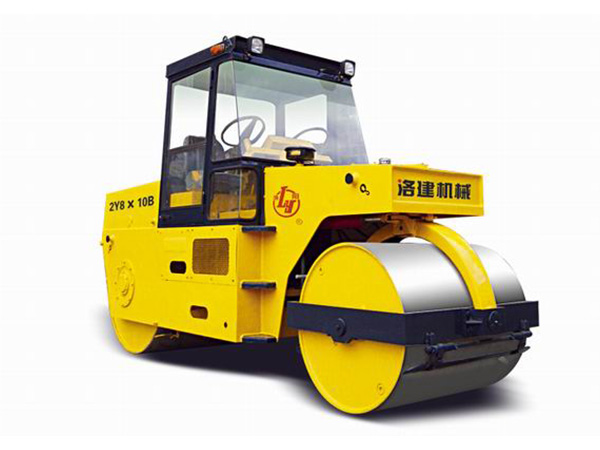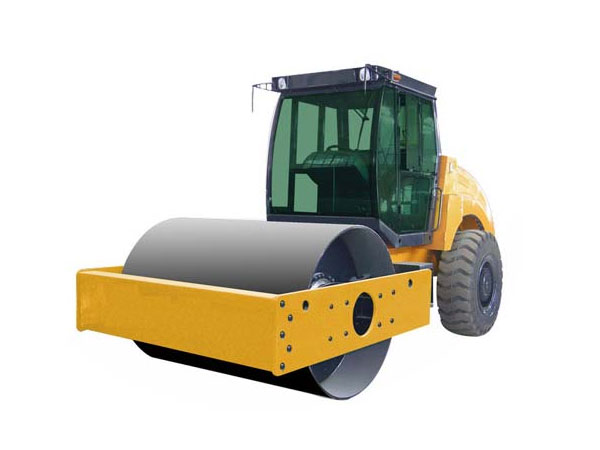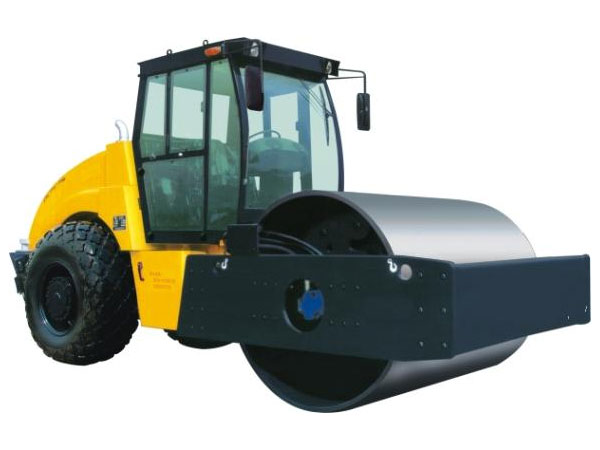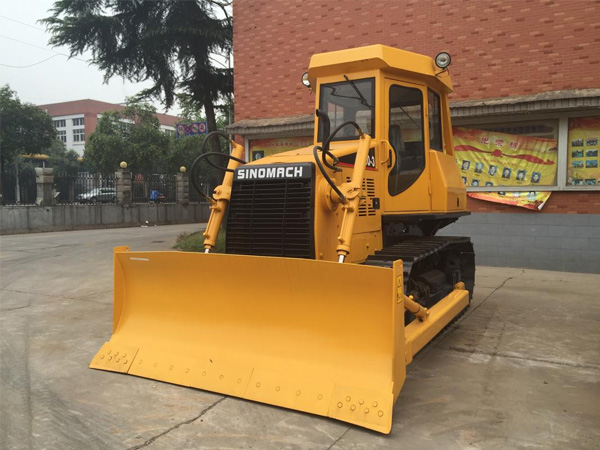Small road rollers are widely used in the edge compaction work of various roads and the second highway compaction. It is a common road compaction machine in our daily life. For people doing engineering, the normal use of the road roller is to ensure the workload The premise is that once the roller fails, the construction period will be delayed. Next, the roller manufacturer will explain to you some common faults and their solutions that are often encountered in the use of small rollers, so that you can repair them in time if there is a failure in use.
1. Common faults of the steering wheel of the road rollers
1. During the operation of the small roller, the steering wheel rotates, swings left and right, and shakes a lot. It is necessary to check whether the position of the rotor and the transmission coupling are correspondingly reasonable or the screws are loose.
2. Broken, deformed and worn dial pins, or broken, deformed, open, or worn transmission linkage shafts will cause the steering wheel to not turn and increase the pressure.
3. When the small road roller automatically deviates during driving, or the vehicle deviates from the direction after turning the steering wheel, check the two-way cushion valve and spring for debris.
2. Common faults in the power system of the road rollers

(1)The engine can’t start?
First of all, we must first analyze the reasons why the engine cannot start: a. Is the fuel used up? b. Is the fuel filter blocked? c. Whether the fuel pipe is leaking. d. The battery is leaking and discharged or the connection is not good.
Then we have to eliminate these reasons one by one: a. Fill the fuel bottle to eliminate the air in the system. b. Replace the filter. c. Check and prohibit tightening of all connections. d. Clamp the electric clamp and check the cable.
(2)The engine is difficult to start or the working power is unstable?
Reasons: a. The battery voltage is too low, and the battery clamps are loose or oxidized, causing the starter to rotate too slowly. b. Engine oil with too much viscosity, especially in winter. c. The fuel supply is not smooth. In winter, paraffin wax will cause blockage of the fuel system. d. Incorrect valve clearance. e. The fuel injector is defective. f. The turbocharger is defective. g. The dry air filter is dirty. h. The vacuum switch is faulty. i. The throttle cable is too tight.
Remedy: a. Check the battery, clean the two clamps to clamp and apply oil to the clamps. b. Use suitable engine oil. c. Replace the fuel filter, check all the fuel pipes, and change to winter fuel when it is cold. d. Adjust the valve clearance. e. Clean or replace. f. Check the vacuum switch. g. Adjust or replace the throttle cable.
(3)The engine overheats or stops suddenly?
Reason: a. The cooling fins of the cylinder and the radiator on the top of the cylinder are blocked by dirt. b. The fuel injector is defective. c. The injection pump is not adjusted correctly. d. The cooling air flow is restricted. e. The fan belt is too loose or broken.
Remedy: a. Clean the radiator cooling fins, especially the vertical fins on the top of the cylinder. b. Have a home inspection. c. Have a home inspection. e. Clean the cooling air delivery pipe. f. Check the belt or replace the belt.
(4)Exhaust too much smoke?
Analysis of the reasons: a. Too much oil. b. The dry air filter is dirty. c. The piston is burned or broken, resulting in insufficient compression plough. d. Incorrect valve clearance.
Remedy: a. Exclude too much oil. b. Clean or replace the filter. c. Inspection by professional personnel. d. Adjust the valve clearance.
(5)Engine oil leakage
It may be due to the large abrasion of the components of the small roller, which leads to the lack of tightness; the quality of the fuel itself and the concentration is not up to the standard; the sealing components have problems; the drive shaft has a large gap. When the hydraulic system of a small roller is running, the pump body is overheated: it may be due to a problem with the pump body, such as extra suction and exhaust; the pump body is damaged and leaks.
(6)The system pressure is not up to or there is no pressure
It may be that the unloading port of the pilot relief valve of the small roller is not blocked, resulting in no pressure in the control oil or no pressure in the hydraulic pump. During construction, the operating frequency of the small rollers suddenly decreases or the oil discharge failure occurs. This phenomenon may be caused by the following reasons: insufficient fuel consumption of the small rollers; relatively large wear and tear of related parts and failure of coordination; limited performance of some machines.
3. Common failure problems of road rollers

(1)The small roller cannot change speed when walking
The speed change mechanism of the roller is divided into two kinds, one is to realize the speed change by a variable motor, and the other is to realize the speed change by a fixed motor and a gearbox.
a. The variable motor mechanism is unable to change speed because the displacement control mechanism of the variable motor cannot be opened normally or malfunctions. First, check whether the walking speed control switch is good, whether the variable speed solenoid valve is normal, and measure the circuit at the solenoid valve. Unobstructed, to ensure that the solenoid valve can be opened smoothly and connected to the variable speed control oil circuit to ensure that its pressure is normal (its pressure is the replenishment pressure). If the top is cut well, the motor is damaged.
b. The quantitative motor gearbox mechanism cannot change speed. The judgment is relatively simple. If the working pressure of the quantitative motor is normal, the gearbox is damaged, and the gearbox can be changed by restoring it.
(2)What is the reason why the small vibratory roller does not vibrate
The reason why small vibratory rollers do not vibrate is mostly due to a problem with the shaft of the thrower. Many of these problems are also caused by some small problems when welding the thrower. Another reason is the problem of the electromagnetic clutch. In addition, if there is a problem with the throttle cable of a small roller with a gasoline engine, the roller will not vibrate.
(3)The parking brake of small rollers fails
The reason analysis should start from the composition, structure and working principle of the parking brake system of the roller. Wet disc brakes are used in the rear axle and front wheel reducer of small rollers, which rely on the friction between the friction plates to generate braking. Torque; if the roller parking brake fails, it must be caused by the slippage of the brake friction plate, which can be analyzed according to its composition, structure and working principle. The braking torque of the brake depends on the surface number of the friction lining, the average radius of the friction lining and the size of the friction force. The surface number and the average radius of the friction lining are designed and manufactured and cannot be changed during the braking process. Then, the brake slip must be caused by the reduced friction.
The pressing force of the brake pressure plate is generated by the pressing spring. If the elastic force of the pressing spring is reduced due to fatigue or plastic deformation caused by heat, the pressing performance of the pressing spring will attenuate. If the brake friction plate becomes thin after wear, The compression spring stretches, according to the inverse relationship between the compression spring force and its free length, so the spring force will decrease, causing the brake to slip. The frictional force of a friction brake depends on the pressure of the pressure plate and also has a great relationship with the friction coefficient of the friction plate. The brake friction lining should have a relatively large friction coefficient. If the friction lining is used for a long time, the friction surface is ablated and hardened, there is oil or moisture, the friction coefficient will be reduced, which will cause the brake to slip.
(4)Heat dissipation of small rollers
For technicians operating small rollers, it should be understood that poor heat dissipation results when the machine is working will directly affect the life of the machine or cause damage to parts.
When a small roller encounters excessive coolant temperature and the hydraulic system cannot dissipate heat normally, it should be judged whether the coolant temperature and the temperature of the heat sink are normal, and the coolant in the heat sink should be replaced. If the high temperature phenomenon occurs again after the coolant is replaced, it should be the leakage of the built-in liquid storage tank of the cooling box, and the parts in the cooling box need to be cleaned or replaced in time.
(5)The fuel line air has air
The diesel engine of the road roller stalled due to lack of diesel in the fuel tank during use. After the diesel engine is turned off, although diesel is added to the fuel tank, air has been in the diesel pipeline at this time, and the fuel supply cannot be restored using a hand oil pump.
In order to remove the air in the diesel pipeline and make the diesel engine start smoothly, we adopt the following methods: First, find a small basin and hold a fixed amount of diesel, and place it at a position slightly higher than the diesel pump; second, connect the fuel tank Remove the diesel pipe of the hand oil pump, and this small basin of diesel oil; again, pump the diesel with the hand oil pump to remove the air in the low-pressure oil circuit; finally, install the diesel pipe connecting the fuel tank to the hand oil pump and test the machine. The diesel engine started normally.
(6)The solenoid valve is damaged
If it is difficult to start a diesel engine, it will take a long time for each start before the diesel engine can barely start. We preliminarily believed that it was caused by poor atomization of the fuel injector, but the inspection of the fuel injector and the fuel injection pump were all good. When the solenoid valve was checked again, it was found that the solenoid was not attractive.
When we remove the start solenoid valve and pull the oil valve stem connecting the fuel injection pump and the solenoid valve by hand, the diesel engine can start smoothly, which shows that the solenoid valve has been damaged. As new solenoid valves are temporarily not available in the nearby market, we use thin copper wires to bind the fuel injection pump stem to prevent it from returning, and thicken the solenoid valve gasket to prevent the fuel injection pump stem hole Oil leaks from the mouth. After the above treatment, the solenoid valve is installed and the roller is put into use, and the new solenoid valve can be replaced after purchasing.

(7)Deformation repair method of front wheel support
When a small roller failed to start, in order to start the roller, a loader was used to push it on the spot. As a result, the box supporting the front wheel of the roller was deformed, and the welding of the front fork and the vertical shaft was misaligned. The roller cannot be used.
Usually the front wheel box, vertical axle and front fork must be disassembled to repair the fault, but this repair is time-consuming and laborious. To this end, we adopted the following simple recovery methods:
First, adjust the front wheel to the front direction;
Secondly, pad the front wheel, front wheel frame and front fork beam with wood so that the front wheel does not rotate when turning the steering wheel;
Once again, turn the steering wheel, remember the total number of turns of the steering wheel, turn to the limit position and then turn back to half the total number of turns, the misaligned front fork and the shaft sleeve of the vertical shaft can return to the correct position; then, remove the front wheel The 14 fixing bolts on both sides of the box are used to lift the front wheel box about 400mm with a jack to leave the front wheel axle;
Finally, use electric welding to weld the vertical shaft sleeve firmly, loosen the jack, drop the front wheel fork, and assemble the front wheel frame with the front wheel shaft. In this way, only one person can adjust the deformation of the front wheel frame in place.
(8)Repair method for poor positioning of shift lever
The positioning pin of the shift lever of the small roller is easy to fall out or be cut off, resulting in the shift lever cannot be positioned. The locating pin has a diameter of 4mm and is used to prevent the shift lever from rotating.
To solve this problem, we adopt the following methods:
First, expand the diameter of the gear lever pin hole to 5mm and tap the M6 internal thread;
Second, modify the width of the shift lever pin groove to 6mm;
Finally, configure one M6 screw and one M6 nut, screw the screw into the seat pin hole, and lock the nut after returning it half a turn.
(9)Solution to oil leakage of sealing ring
The vibrating valve of the roller leaked oil. After replacing the Y-shaped sealing ring, oil leaks occurred after a short period of use. The inspection found that after long-term use of the vibrating valve, the valve core upper cover and the valve core were severely worn.
To solve this problem, we adopt the method of adding O-shaped or flat-shaped sealing ring, that is, installing O-shaped or flat-shaped sealing ring in the groove of Y-shaped sealing ring. The vibration valve did not leak oil after the sealing ring was installed, which proved that the method achieved good results.






















